Please use this identifier to cite or link to this item:
https://hdl.handle.net/10316.2/34152| DC Field | Value | Language |
|---|---|---|
| dc.contributor.author | Díaz-Raviña, M. | |
| dc.contributor.author | Martín, A. | |
| dc.contributor.author | Barreiro, A. | |
| dc.contributor.author | Lombao, A. | |
| dc.contributor.author | Vega, J.A. | |
| dc.contributor.author | Fontúrbel, M.T. | |
| dc.contributor.author | Fernández, C. | |
| dc.contributor.author | Carballas, T. | |
| dc.date.accessioned | 2014-10-21T14:50:24Z | |
| dc.date.accessioned | 2020-09-09T21:32:08Z | - |
| dc.date.available | 2014-10-21T14:50:24Z | |
| dc.date.available | 2020-09-09T21:32:08Z | - |
| dc.date.issued | 2014 | - |
| dc.identifier.isbn | 978-989-26-0884-6 (PDF) | |
| dc.identifier.uri | https://hdl.handle.net/10316.2/34152 | - |
| dc.description.abstract | The effect of two post-fire stabilization treatments (seeding and mulching) on some selected physical, chemical, biochemical and microbiological properties as well as the efficacy of these treatments on post-fire erosion control was investigated. The study was performed in two scrubland areas of Galicia (N.W. Spain), susceptible to suffer post-fire erosion (slope 30-50%) after an experimental fire and a wildfire, respectively. Soil samples were taken from the A horizon at different sampling times over one year after the fire event as well as from the corresponding unburnt soil located in an adjacent plot used as control; the sediments from the burnt soils, with and without different post-fire stabilisation treatments, were periodically collected after precipitation events. The results showed that initially the wildfire induced important changes in most properties measured and that these effects persisted 12 months after the fire; in contrast, the experimental fire provoked slight changes in the physic-chemical and chemical properties but moderate changes in the biochemical properties. They also indicated that both stabilisation treatments had no effects on the soil properties analysed and then on soil quality, but reduced significantly the sediments yield compared to the control burnt soil. The mean efficiency of the seeding and mulching treatments in preventing soil erosion was 21-31% and 85-88%, respectively, showing that, in the short- and medium-term (12 months), the straw mulching was the most effective treatment for reducing the post-fire erosion in both burnt areas. | eng |
| dc.language.iso | eng | - |
| dc.publisher | Imprensa da Universidade de Coimbra | por |
| dc.relation.ispartof | http://hdl.handle.net/10316.2/34013 | por |
| dc.rights | open access | - |
| dc.subject | Experimental fire | eng |
| dc.subject | Wildfire | eng |
| dc.subject | Soil quality | eng |
| dc.subject | Post-fire soil erosion | eng |
| dc.subject | Post-fire rehabilitation | eng |
| dc.title | Implementation of different techniques for controlling post-fire erosion in the N.W. of the Iberian Peninsula | por |
| dc.type | bookPart | por |
| uc.publication.firstPage | 1713 | - |
| uc.publication.lastPage | 1722 | - |
| uc.publication.location | Coimbra | por |
| dc.identifier.doi | 10.14195/978-989-26-0884-6_188 | - |
| uc.publication.section | Chapter 6 – Forest Management | por |
| uc.publication.digCollection | PB | por |
| uc.publication.orderno | 188 | - |
| uc.publication.area | Ciências da Engenharia e Tecnologias | por |
| uc.publication.bookTitle | Advances in forest fire research | - |
| uc.publication.manifest | https://dl.uc.pt/json/iiif/10316.2/34152/211875/manifest?manifest=/json/iiif/10316.2/34152/211875/manifest | - |
| uc.publication.thumbnail | https://dl.uc.pt/retrieve/11177459 | - |
| uc.publication.parentItemId | 53868 | - |
| uc.itemId | 70408 | - |
| item.fulltext | With Fulltext | - |
| item.grantfulltext | open | - |
| Appears in Collections: | Advances in forest fire research | |
Files in This Item:
| File | Description | Size | Format | |
|---|---|---|---|---|
| 978-989-26-0884-6_188.pdf | 2.19 MB | Adobe PDF |  |
Items in DSpace are protected by copyright, with all rights reserved, unless otherwise indicated.
